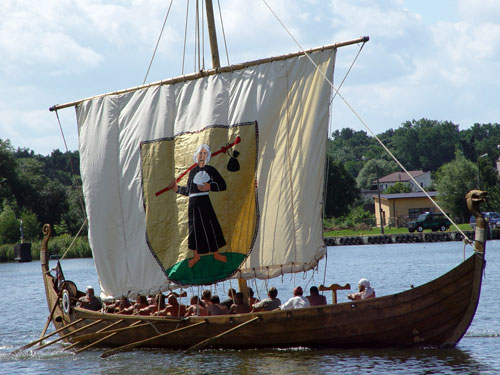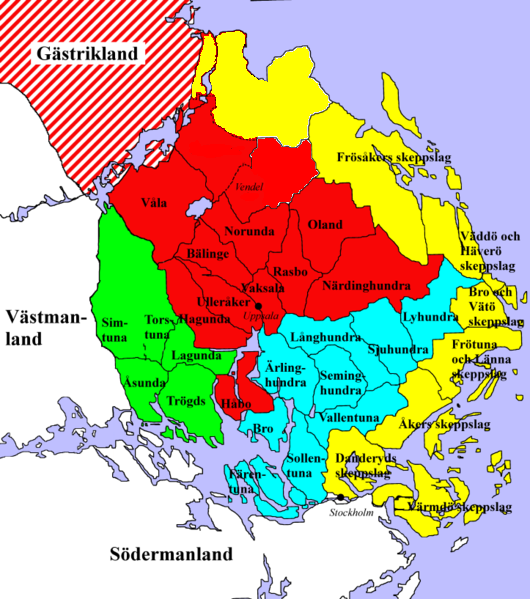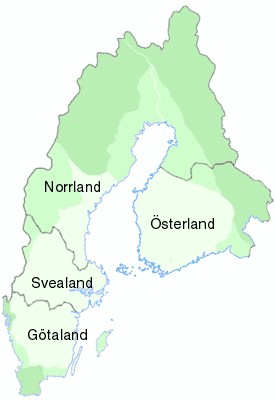|
Leidang
The institution known as ''leiðangr'' (Old Norse), ''leidang'' (Norwegian), ''leding'' (Danish), ''ledung'' (Swedish), ''expeditio'' (Latin) or sometimes lething (English), was a form of conscription ( mass levy) to organize coastal fleets for seasonal excursions and in defense of the realm typical for medieval Scandinavians and, later, a public levy of free farmers. In Anglo-Saxon England, a different system was used to achieve similar ends, and was known as the fyrd. The first recorded instance of a Norse lething is disputed among scholars. There is considerable evidence that substantiates its existence in the late 12th century. However, there are also written sources and archeological evidence which indicate that the lething system was introduced as early as the tenth century, if not earlier. Origins The age of the lething is disputed among scholars. The Icelandic sagas link the introduction of the lething to King Haakon I (The Good) of Norway in the tenth century. The first k ... [...More Info...] [...Related Items...] OR: [Wikipedia] [Google] [Baidu] |
Roslagen
Roslagen is the name of the coastal areas of Uppland province in Sweden, which also constitutes the northern part of the Stockholm archipelago. Historically, it was the name for all the coastal areas of the Baltic Sea, including the eastern parts of lake Mälaren, belonging to Svealand. The name was first mentioned in the year 1493 as "Rodzlagen". Before that the area was known as ''Roden''. Roden had a ''skeppslag'' (roughly translated: ship district), the coastal equivalent to the inland Hundreds. When the king would issue a call to leidang, the Viking Age equivalent of military conscript service, the ''skeppslag'' in Roden was responsible for raising ships for the leidang navy. The name comes from the ''rodslag'', which is an old coastal Uppland word for a rowing crew of warrior oarsmen. Etymologically, Roden, or Roslagen, is the source of the Finnish and Estonian names for Sweden: and .The Russian Primary Chronicle: Laurentian Text Translated by O. P. Sherbowitz-Wetzor ... [...More Info...] [...Related Items...] OR: [Wikipedia] [Google] [Baidu] |
Viking Ships
Viking ships were marine vessels of unique structure, used in Scandinavia from the Viking Age throughout the Middle Ages. The boat-types were quite varied, depending on what the ship was intended for, but they were generally characterized as being slender and flexible boats, with symmetrical ends with true keel. They were Clinker (boat building), clinker built, which is the overlapping of planks riveted together. Some might have had a dragon's head or other circular object protruding from the bow and stern for design, although this is only inferred from historical sources. Viking ships were used both for military purposes and for long-distance trade, exploration and colonization. In the literature, Viking ships are usually seen divided into two broad categories: merchant ships and warships, the latter resembling narrow "war canoes" with less load capacity, but higher speed. However, these categories are overlapping; some transport ships would also form part of war fleets. As a ru ... [...More Info...] [...Related Items...] OR: [Wikipedia] [Google] [Baidu] |
Law Of Uppland
The Law of Uppland (; ) was the law that applied in Uppland, Sweden, from 1296 to the beginning of the 1350s. It was drafted by a Royal commission, enacted at the three Folkland (Swedish provinces), Folkland Thing (assembly), Things, and given Royal assent in 1296. The Law of Uppland became the law of the land, not only for the province of Uppland it created, containing the three Folklands and Roden, Sweden, Roden, but also for Gästrikland. The law contained eight law codes: The Church, King's, Heritance, Freeman's, Land, Merchant's, Neighborhood, and Thing codes. Courts were held in each Hundred (county division), Hundred and each Folkland. There were no public prosecutors, and no material difference between criminal and civil cases existed. Suits in law would be initiated by the parties. Legal proceedings were of three kinds: trial by Witness, eyewitnesses, trial by compurgation and trial by jury. Background In early medieval Sweden, each (Provinces of Sweden, province) was ju ... [...More Info...] [...Related Items...] OR: [Wikipedia] [Google] [Baidu] |
Harald Hardrada
Harald Sigurdsson (; – 25 September 1066), also known as Harald III of Norway and given the epithet ''Hardrada'' (; modern no, Hardråde, roughly translated as "stern counsel" or "hard ruler") in the sagas, was King of Norway from 1046 to 1066. Additionally, he unsuccessfully claimed both the Danish throne until 1064 and the English throne in 1066. Before becoming king, Harald had spent around fifteen years in exile as a mercenary and military commander in Kievan Rus' and as a chief of the Varangian Guard in the Byzantine Empire. When he was fifteen years old, in 1030, Harald fought in the Battle of Stiklestad together with his half-brother Olaf Haraldsson (later Saint Olaf). Olaf sought to reclaim the Norwegian throne, which he had lost to the Danish king Cnut the Great two years prior. In the battle, Olaf and Harald were defeated by forces loyal to Cnut, and Harald was forced into exile to Kievan Rus' (the sagas' ). He thereafter spent some time in the army of Grand Pr ... [...More Info...] [...Related Items...] OR: [Wikipedia] [Google] [Baidu] |
Tribal Chief
A tribal chief or chieftain is the leader of a tribal society or chiefdom. Tribe The concept of tribe is a broadly applied concept, based on tribal concepts of societies of western Afroeurasia. Tribal societies are sometimes categorized as an intermediate stage between the band society of the Paleolithic stage and civilization with centralized, super-regional government based in cities. Anthropologist Elman Service distinguishes two stages of tribal societies: simple societies organized by limited instances of social rank and prestige, and more stratified societies led by chieftains or tribal kings (chiefdoms). Stratified tribal societies led by tribal kings are thought to have flourished from the Neolithic stage into the Iron Age, albeit in competition with urban civilisations and empires beginning in the Bronze Age. In the case of tribal societies of indigenous peoples existing within larger colonial and post-colonial states, tribal chiefs may represent their tribe or ... [...More Info...] [...Related Items...] OR: [Wikipedia] [Google] [Baidu] |
Sweden
Sweden, formally the Kingdom of Sweden,The United Nations Group of Experts on Geographical Names states that the country's formal name is the Kingdom of SwedenUNGEGN World Geographical Names, Sweden./ref> is a Nordic country located on the Scandinavian Peninsula in Northern Europe. It borders Norway to the west and north, Finland to the east, and is connected to Denmark in the southwest by a bridgetunnel across the Öresund. At , Sweden is the largest Nordic country, the third-largest country in the European Union, and the fifth-largest country in Europe. The capital and largest city is Stockholm. Sweden has a total population of 10.5 million, and a low population density of , with around 87% of Swedes residing in urban areas in the central and southern half of the country. Sweden has a nature dominated by forests and a large amount of lakes, including some of the largest in Europe. Many long rivers run from the Scandes range through the landscape, primarily ... [...More Info...] [...Related Items...] OR: [Wikipedia] [Google] [Baidu] |
Svealand
Svealand (), or Swealand, is the historical core region of Sweden. It is located in south central Sweden and is one of three historical lands of Sweden, bounded to the north by Norrland and to the south by Götaland. Deep forests, Tiveden, Tylöskog, and Kolmården, separated Svealand from Götaland. Historically, its inhabitants were called , from which is derived the English 'Swedes'. Svealand consists of the capital region Mälardalen in the east, Roslagen in the north-east, the former mining district Bergslagen in the center, and Dalarna and Värmland in the west. The older name of Sweden in Swedish, (modern spelling: ) Realm of the Swedes, "Swea Region", originally only referred to Svealand. Other forms are (Old Norse/ Icelandic ), and . As the domains of the Swedish kings grew, the name Svealand began to be used to separate the original territory from the new. Provinces Svealand is made up of the following six provinces: *Dalarna *Närke *Södermanland *Uppland *V� ... [...More Info...] [...Related Items...] OR: [Wikipedia] [Google] [Baidu] |
Hundred (county Division)
A hundred is an administrative division that is geographically part of a larger region. It was formerly used in England, Wales, some parts of the United States, Denmark, Southern Schleswig, Sweden, Finland, Norway, the Bishopric of Ösel–Wiek, Curonia, the Ukrainian state of the Cossack Hetmanate and in Cumberland County in the British Colony of New South Wales. It is still used in other places, including in Australia (in South Australia and the Northern Territory). Other terms for the hundred in English and other languages include ''wapentake'', ''herred'' (Danish and Bokmål Norwegian), ''herad'' ( Nynorsk Norwegian), ''hérað'' (Icelandic), ''härad'' or ''hundare'' (Swedish), ''Harde'' (German), ''hiird'' ( North Frisian), ''satakunta'' or ''kihlakunta'' (Finnish), ''kihelkond'' (Estonian), ''kiligunda'' (Livonian), '' cantref'' (Welsh) and ''sotnia'' (Slavic). In Ireland, a similar subdivision of counties is referred to as a barony, and a hundred is a subdivision of a pa ... [...More Info...] [...Related Items...] OR: [Wikipedia] [Google] [Baidu] |
Jarl (title)
Jarl is a rank of the nobility in Scandinavia. In Old Norse, it meant "Germanic chieftain, chieftain", particularly a chieftain set to rule a territory in a king's stead. ''Jarl'' could also mean a sovereign prince. For example, the rulers of several of the petty kingdoms of Norway had the title of ''jarl'' and in many cases they had no less power than their neighbours who had the title of king. It became obsolete in the Middle Ages and was replaced by duke (''hertig''/''hertug''/''hertog''). The word is etymologically related to the English earl. Etymology The term ''jarl'' has been compared to the name of the Heruli, and to runic ''erilaz''. Proto-Norse ''eril'', or the later Old Norse , came to signify the rank of a leader. Norway In later medieval Norway, the title of ''jarl'' was the highest rank below the king. There was usually no more than one ''jarl'' in mainland Norway at any one time, and sometimes none. The ruler of the Norwegian dependency of Orkney held the ti ... [...More Info...] [...Related Items...] OR: [Wikipedia] [Google] [Baidu] |
Västmanland
Västmanland ( or ), is a historical Swedish province, or ''landskap'', in middle Sweden. It borders Södermanland, Närke, Värmland, Dalarna and Uppland. Västmanland means "(The) Land of the Western Men", where the "western men" (''västermännen'') were the people living west of Uppland, the core province of early Sweden. Administration The traditional provinces of Sweden serve no administrative or political purposes (except sometimes as sport districts), but are historical and cultural entities. In the case of Västmanland the corresponding administrative county, Västmanland County, constitutes the eastern part of the province. The western part is in Örebro County where the municipalities of Hällefors, Lindesberg, Ljusnarsberg and Nora are located. Heraldry The coat of arms was granted in 1560. At the time it featured one fire mountain, to represent the mine of Sala Municipality. Soon, their numbers were increased to three, to also symbolize the Lindesberg and ... [...More Info...] [...Related Items...] OR: [Wikipedia] [Google] [Baidu] |
Uppland
Uppland () is a historical province or ' on the eastern coast of Sweden, just north of Stockholm, the capital. It borders Södermanland, Västmanland and Gästrikland. It is also bounded by lake Mälaren and the Baltic Sea. On the small uninhabited island of Märket in the Baltic, Uppland has a very short and unusually shaped land border with Åland, an autonomous province of Finland. The name literally means ''up land'', a name which is commonly encountered in especially older English literature as ''Upland''. Its Latinised form, which is occasionally used, is ''Uplandia''. Uppland is famous for having the highest concentration of runestones in the world, with as many as 1,196 inscriptions in stone left by the Vikings. Administration The traditional provinces of Sweden serve no administrative or political purposes, but are historical and cultural entities. The corresponding administrative county, or ', is Uppsala County, which occupies the larger part of the territory. The b ... [...More Info...] [...Related Items...] OR: [Wikipedia] [Google] [Baidu] |
Hundred (county Subdivision)
A hundred is an administrative division that is geographically part of a larger region. It was formerly used in England, Wales, some parts of the United States, Denmark, Southern Schleswig, Sweden, Finland, Norway, the Bishopric of Ösel–Wiek, Curonia, the Ukrainian state of the Cossack Hetmanate and in Cumberland County, New South Wales, Cumberland County in the British Colony of New South Wales. It is still used in other places, including in Australia (in South Australia and the Northern Territory). Other terms for the hundred in English and other languages include ''#wapentake, wapentake'', ''herred'' (Danish and Bokmål, Bokmål Norwegian), ''herad'' (Nynorsk, Nynorsk Norwegian), ''hérað'' (Icelandic), ''härad'' or ''hundare'' (Swedish), ''Harde'' (German), ''hiird'' (North Frisian language, North Frisian), ''satakunta'' or ''kihlakunta'' (Finnish), ''kihelkond'' (Estonian), ''kiligunda'' (Livonian), ''cantref'' (Welsh) and ''sotnia'' (Slavic). In Ireland, a similar subdi ... [...More Info...] [...Related Items...] OR: [Wikipedia] [Google] [Baidu] |





.jpg)
